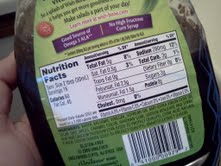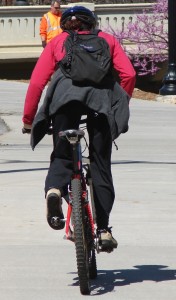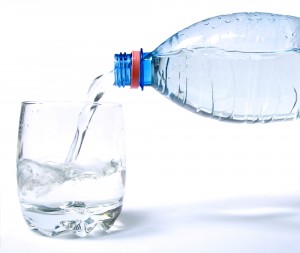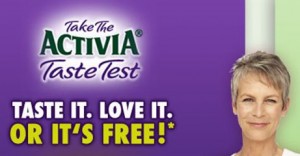Archive for the ‘Health’ Category
You’ve probably read the phrase “smart substitutes” in some of my previous posts. If you’re trying to lead a healthier lifestyle or lose some weight (or both), then these two simple words can change everything for you. Take them to heart and know that by choosing a few “smart substitutes” on a consistent basis, you make some pretty big changes without feeling much sacrifice.
 Making smarter choices by going with substitutes for foods higher in fat or calories requires a little detective work, but you can handle it. You’ve got to read labels. Yes, I know you’re often in a hurry at the grocery, but simply grabbing what’s handy, on sale, or new is not a component of a healthy lifestyle.
Making smarter choices by going with substitutes for foods higher in fat or calories requires a little detective work, but you can handle it. You’ve got to read labels. Yes, I know you’re often in a hurry at the grocery, but simply grabbing what’s handy, on sale, or new is not a component of a healthy lifestyle.
Think of the grocery as a peaceful time to focus on your goals. Give yourself some extra time to read labels, make carefully considered choices, and to picture yourself healthier and happier. Exercising control over your food purchases means a far riskier situation at home, health-wise. With smart shopping choices being made in the store, healthier nutrition becomes much easier at home, whether you’re grabbing a snack or cooking a meal from scratch. Simple modifications to your menu – using smart choices – can literally save hundreds of calories and tons of fat.
The biggest label no-no is sugar. If sugar (or a form of sugar) is one of the first three ingredients listed on a package, that likely means that particular food or drink is very high in sugar. Choose a substitute.
Give yourself a double boost by eating wisely at breakfast to kick-start your day. Replace pork bacon or sausage with turkey or soy. The difference in calories is shocking, and the taste is still there.
Replace a donut or Danish with an English muffin spread with natural peanut butter and fruit spread. I promise you, you’ll be satisfied. Opt for whole wheat toast or bagels, and trans-free canola margarine instead of butter. Omega-3-enriched eggs, egg whites or egg substitutes are also smart substitutes. Replace cornflakes and milk with bran flakes and skim millk.
Light mayo is crucial to weight maintenance; keep it in the fridge. Turn your breaded chicken or fish patties into the grilled variety, and try some of today’s amazing veggie burgers. Don’t tell the family up front they’re about to experience a change; there’s every chance the new flavors will appeal.
Side dishes can add loads of unnecessary fat and calories. Substitute brown rice, steamed veggies, tossed salad with vinaigrette, fruit salad or carrot sticks for fries, potato salad, or white rice. Have you noticed how many white foods I’m recommending a substitute for?
Your new favorite words are broiled, boiled, steamed, sautéed, grilled, and raw. Think of them as six wonderful, tasty, life-enhancing alternatives to one artery-clogging, fat-producing word: “fried.”
After all, isn’t that the point? You want to enhance your life, to feel good and have longevity to enjoy all the great things that might come your way. Start at 20, 40, or 60 … but just start. You only get one go-around!
Side Dishes
Coleslaw Tossed salad w/ vinaigrette dressing
French fries Fruit salad or carrot sticks
French fries Oven fries or baked potato
Potato salad with mayo Potato salad with light mayo
Fried vegetables Steamed vegetables
White rice Brown rice or wild rice
Couscous Whole wheat couscous or quinoa
Dinner Entrees
Breaded fried chicken breast Skinless roasted chicken breast
Breaded fried fish Broiled fish filet
Breaded fried shrimp Boiled or sautéed shrimp
Beef ribs or prime rib Beef sirloin or round steak
Pork chops Turkey breast
Meat pizza with extra cheese Veggie pizza with less cheese
Pasta with cream sauce Pasta with marinara sauce
Regular ground beef Extra lean ground beef
Regular ground beef Ground turkey breast
Regular ground beef Veggie burger crumbles
Sauces
Creamy salad dressing Vinaigrette salad dressing
Creamy salad dressing Olive oil and vinegar
Cream sauce Lowfat cream of mushroom soup
SpreadsRegular mayonnaise Light or nonfat mayonnaise
Regular cream cheese Light or nonfat cream cheese
Regular peanut butter Natural peanut butter
Jelly or jam Fruit spread or apple butter
Dairy Products
Whole ricotta cheese Nonfat ricotta cheese
Heavy cream Evaporated skim milk
Whole milk Low fat or nonfat milk
Whole yogurt Low fat or nonfat yogurt
Whole cottage cheese Low fat or nonfat cottage cheese
Regular cheese Reduced fat or soy cheese
Regular sour cream Light or nonfat sour cream or plain yogurt (for extra calcium)
SnacksRoasted peanuts Homemade mix: walnuts, almonds, raisins, cranberries, peanuts
Regular butter popcorn or “kettle corn” Light microwave popcorn
Regular potato chips Light or baked potato chips
Regular corn chips Light or baked tortilla chips
Butter flavor crackers Whole wheat crackers
Nacho cheese dip Black bean dip or salsa
DessertsRegular ice cream Low fat or nonfat frozen yogurt
Ice cream bar Frozen fruit bar
Milk chocolate candy bar Dark chocolate candy bar
Cheesecake Graham crackers topped with light cream cheese and strawberry spread
Fruit pie in pastry shell Fresh fruit crisp
Strawberries with custard Strawberries with nonfat pudding
Candy bar Granola bar
Thanks to actress Jamie Curtis and her TV ads for Dannon’s Activia, you’ve probably heard of the term “probiotics.” Probiotics are, simply, “good bacteria” … natural living micro-organisms which are most often found in dairy products. I like to think of them as a little army of health warriors, fighting to keep me balanced.
Americans have become much more proactive when it comes to digestive health, and probiotics are a critical component of happy innards. Sure, it’s a slightly unappealing subject, but having health concerns in that area is no fun at ALL, so I like to arm you with information to keep you on the offense, rather than the defense.
Probiotics promote a healthy colon, but they also improve the immune system’s overall function AND are proven to raise levels of good cholesterol. How can you beat that?
Many people look for probiotics via nutritional supplements but I will always advocate for eating the right food over popping a pill, especially when it’s tasty. The amounts of live cultures found in the right foods and drinks are far greater than what you’ll find in a pill or tablet. So just enjoy a little yogurt for breakfast or midday snack. Good health can be delicious.
Product packaging will make you think all yogurts all equally healthy, but one or two brands offer far more living cultures. All yogurts do have good bacteria in them, but if your budget allows, opt for the gold standard (Dannon’s Activia, Yo Plus, Stoneyfield). Stoneyfield milk and sour cream also contain the “good bacteria.” Add a bit of one of these foods to your daily diet.
For the record, probiotics or “live cultures” – when not the main marketing angle of a food product – also go by a host of very long, very Latin names: L. caseii immunitass, Lactobacillus acidophilus, Bifidus essensis and Lactobacillus rhamnosus GG.
The list of symptoms eased by these helpful micro-organisms includes lactose intolerance and irritable bowel. Research has been done on probiotics in regard to other issues, too, including reducing the occurrence of bladder cancer and even eczema prevention in kids.
Now here’s what Paul Harvey would have called “the rest of the story.” There’s also a thing called prebiotics. Simply put, prebiotics are the food to feed the good bacteria. Many prebiotics are classified as dietary fiber and the body does not fully digest them.
Foods with both prebiotics and probiotics are known as synbiotic. (Huge points for this word in Scrabble!) Synbiotics may help support probiotic bacteria by stimulating their growth and making them more active, all of which improves the balance of “good” bacteria in the GI system.
While you chew on that, please focus on the fact that you can give your body what it needs by simply eating the right things. If you need extra guidance, motivation or accountability, call a registered dietitian. Associates in Nutrition has special discounts monthly for nutrition counseling, fitness and wellness. Call 239-826-2021 or visit AssociatesinNutrition.com.
How probiotics affect you depends on a host of factors, but the main thing to remember is that while probiotics are likely to improve your digestive health, they’re not a cure for digestive problems. I encourage you to take action, and fend off a problem before it occurs. Get out your spoons and say “En guard!”
Now here’s what Paul Harvey would have called “the rest of the story.” There’s also a thing called prebiotics. Simply put, prebiotics are the food to feed the good bacteria. Many prebiotics are classified as dietary fiber and the body does not fully digest them.
Foods with both prebiotics and probiotics are known as synbiotic. (Huge points for this word in Scrabble!) Synbiotics may help support probiotic bacteria by stimulating their growth and making them more active, all of which improves the balance of “good” bacteria in the GI system.
While you chew on that, please focus on the fact that you can give your body what it needs by simply eating the right things. If you need extra guidance, motivation or accountability, call a registered dietitian.
You don’t have to be a hard-core athlete to appreciate endurance. Sometimes we want to push ourselves physically, for all sorts of reasons. Walking 18 holes. Winning the football game. Playing doubles. Running that annual 5K. A long bike ride on Saturday.
 So it’s “competition” day . . . now what? You may have trained and trained, but have you consistently fueled your body with the right substances (foods and fluids)? It really matters what fuel you choose; why wouldn’t it? And the body’s energy is finite: if it’s not resupplied, it will run out. Push it hard, it runs out faster. Fuel incorrectly, and all your training will be for naught. What a pity.
So it’s “competition” day . . . now what? You may have trained and trained, but have you consistently fueled your body with the right substances (foods and fluids)? It really matters what fuel you choose; why wouldn’t it? And the body’s energy is finite: if it’s not resupplied, it will run out. Push it hard, it runs out faster. Fuel incorrectly, and all your training will be for naught. What a pity.
Here are some Keys to give you a competitive edge. They will unlock a new level of physical success for you, in whatever arena you need it.
Key #1. Plan, plan, plan. You already know you need to prepare physically for an event. But even more key is planning ahead nutritionally. Take time to learn how starches, carbs, protein and hydration fuel the body for highly physical endeavors, and how they’re also used to help it recover quickly, building lean muscle tissue as a result. I’ve given you some great starter tips below.
Key #2. Practice, practice, practice . . . but I don’t mean training! Literally practice your “competition day” eating before that important event. A coach once told me ‘ if you put the maximum effort into your practice, you will have the maximum benefit during your game days.’ Now I tell all my athletes that same thing.
Key #3. Fuel properly the night before. The big pre-competition “no-no’s” are 1) anything with a lot of sugar; 2) fried or spicy foods; 3) high fat foods: gravies, sauces, creamy soups, fatty meats. And DON’T try any foods you’ve never eaten before.
Key #4. Same no-no’s apply on game day. Eat starches approximately 3-4 hours prior to your event, and make the portions slightly smaller than normal meal. They give you “timed-release” energy. About 30-60 minutes before starting the event, top off your tank with fluids and a small snack (a piece of fruit or granola bar).
Key #5. During your competition (or on tournament days with multiple events or games) make sure you’re drinking at least 8-12 ounces of fluids between each game or event. Eat a healthy snack – such as yogurt, a sports bar or trail mix – between each game and event. If you’re exercising for longer than an hour without taking a long break, you need to keep refueling during the event, with foods like pretzels, fruit, granola or fruit snacks. Remember: drink plenty of fluids!
Key #6. When in doubt DON’T go without! Some people find that liquids are easier on their stomachs while they exercise. But what’s in the liquid is critical. Don’t go without proteins or nutrients; try chocolate milk, smoothies, or meal replacement shakes.
Got it? Plan ahead, practice, hydrate and don’t go without fuel.
Whether you’re trying to lose weight, lower your sugar intake for overall well-being, or wean your kids off sugar, you need to recognize sugar in its many forms. It’s amazing how many different words mean “sugar” on the contents label of a food or drink.
It’s also unbelievable how many food products include sugar in one form or another. To boost to your wellness plan, you have to know sugar terminology, and you have to know how to interpret the label (and teach your kids). The top three ingredients listed on the label are primary, so if you see a sugary term there, the product is loaded.
Some ingredients to watch out for: corn sweeteners, evaporated can juice, cane sugar, high fructose corn syrup, confectioner’s sugar, dextrin, honey, invert sugar, maple sugar, raw sugar, malt molasses, turbinado sugar, brown and white sugars.
I was also taught, while earning my dietitian degree, that “if it ends in OSE, it means sugar.”
Sucrose, lactose, dextrose and maltose … Watch out!
Sugar has invaded many products where you don’t expect to find it. I’m talking about things such as salad dressings, canned foods, pasta sauces, lunchmeats, “healthy” cereals and granola bars, dried fruit snacks, and more.
It’s no wonder the average American consumes 128 pounds of sugar per year. Prepared foods are hiding pounds of sugar, and adding pounds of fat, especially to our kids, who are at grave risk for diabetes. (Ouch, that hurts me to just write that).
Hopefully you’re aware how much sugar is packed into a regular soda, but sports and energy drinks are culprits that often fly under the radar. Because their purpose is “beneficial,” these drinks make it easy to forget that their labels are also important. But that 20-ounce Powerade you rely on to hydrate you has more than 8 teaspoons of sugar in it!
Some other big offenders (teaspoons of sugar per drink in ounces)
- Propel: 1.5 tsp per 16 ounces
- Vitamin Water: 7 tsp per 20 ounces (this one surprised me).
- Regular Powerade: 8.3 tsp per 20 ounces *
* Powerade and Gatorade do have low sugar options.
Sports Drinks
- Full Throttle: 13.8 tsp per 16 ounces
- Jolt Energy: 22.3 tsp per 23.5 ounces
- Amp: 7.3 tsp per 8.4 ounces
- Monster: 12.8 tsp per 16 ounces
Other drinks that pack in the sugar
- 7-up: 9 tsp sugar per 12 ounces
- A & W Cream Soda: 11 tsp sugar per 12 ounces
- Average cola: 10 tsp per 12 ounces
- Nestlé’s Ice Tea: 8-14 tsp sugar per 16-20 ounces
The bottom line: high sugar intakes are contributing to an epidemic of obesity in this country.
 We’ve all heard certain “facts” about nutrition so many times that we take them at face value, no longer questioning their validity. I’m going to knock a hole in a few of the things we “know” to be true about food.
We’ve all heard certain “facts” about nutrition so many times that we take them at face value, no longer questioning their validity. I’m going to knock a hole in a few of the things we “know” to be true about food.
Let’s start with the food that’s hardest to avoid: sugar. Those who’ve ever attempted the Atkins Diet or simply tried to avoid sugar probably got a rude awakening when they started reading labels. Sugar is hiding everywhere: lunch meat, ketchup, salad dressings. The average person in the U.S. consumes about “128 pounds” a year, or 34 teaspoons a day. Super-size fountain drink, anyone?
But what about sugar causing hyperactivity in kids? Controlled studies prove that’s false. And doesn’t eating sugar put a person at risk for diabetes? No. What causes diabetes is lack of activity, being overweight and a high-calorie diet. Diabetes patients have to cut way down on sugar, but just don’t go there.
Perhaps you’ve heard that brown sugar is healthier than white sugar. Sorry to disappoint, but brown sugar is white granulated sugar with molasses added. The mineral content between the two is insignificant at the end of the day.
Sugar is a refined food that’s been stripped of fiber, water, vitamins and minerals. Avoid foods that list a variant of it as its first three ingredients. This includes dextrose, lactose, sucrose and maltose. Sugar is calories without nutrients, so picture that 128-pound pile and try to make a dent in it.
The “brown vs. white” myth has carried over into the egg department as well. While they may look more natural, brown eggs have no additional nutritional benefits over white. Nor are they higher quality or more flavorful. Hen color determines the eggshell color. White feather hens lay white eggs; red feather hens lay brown eggs.
While we’re on the subject of protein, I’ll dispel a few other myths.
Low-carb diets will cause temporary weight loss but are not a good long-term idea. You may end up ingesting too much cholesterol, which ups the risk of heart disease. Too few fruits and whole grains can lead to a lack of fiber and constipation. Too few carbs can also make a person feel tired, weak or nauseous. Being wobbly at a party can really detract from a girl’s beautiful size 6 cocktail dress.
Another risk of too few carbs is the buildup of ketones in your blood. The kickoff of the Atkins diet is designed to put your body “in ketosis” … but over time, these ketones cause the body to produce a lot of uric acid, a risk factor for joint swelling (gout) and kidney stones. You’ll also notice your new bad breath, and your friends may too.
Ketosis makes the body use fat instead of carbs as an energy source. The weight you lose may well be lean muscle and water. So much better to reduce calories, fat and exercise.
Final myth: cabbage soup and grapefruit burn fat. Nope, sorry, reread the last few paragraphs. You’ll just lose water weight, lean muscle and feel tired and queasy. And that’s the truth!

It’s football season! Many of us wait anxiously for fall and all the fantastic on-field mash-ups it brings. Whether you’re watching your own kids at a nearby ball field, setting up a full-fledged tailgate party in a parking lot, or hosting a big watch party, you do have healthy menu options that are still tasty!
Let’s talk about dogs. A great alternative to the traditional hot dog is a turkey brat. Here’s the trick: boil them in beer. They’ll come out with a lot of flavor, and you’ll have just saved about 300 calories and 26 g of fat. Soak them in mustard for even more flavor. If you’re counting calories, eat yours without the bun (but you already knew that).
My favorite kebabs don’t even require a grill – how easy is that? Load your skewers with varying combinations of the following: cherry tomatoes, mozzarella cubes, artichoke hearts and black olives. Put them in a pan and drizzle them with low-fat Balsalmic vinaigrette or low-fat Italian dressing. These Italian-style “hearty skewers” are very filling . . . and delicious.
If you or your gang likes wings, swap out boneless, skinless chicken for wings. Experiment with marinades and sauces until you find one you like best. I like a nice lemon-mustard marinade, and a light honey mustard is also goof. You can even use barbecue sauce since you’ve given up the chicken skin. If you find a sauce that simulates the traditional flavor of wings, by all means, cut up some celery to accompany, but opt for low-fat or fat-free sour cream.
A boiled shrimp tray is a nice way to throw a little protein at your gang without a lot of fat, and cocktail sauce isn’t on my no-no list. These also require no cooking, another big plus!
I don’t have to tell you that a raw veggie platter is 100% healthy and satisfies the urge to crunch and chew. But if you absolutely have to have something salty, swap out your regular chips and dip for baked chips and salsa. Lays and Doritos both come in a baked version. The salsa cuts out all the calories and fat found in the sour cream which serves as a base for so many dips. You can also look for vegetable chips, which provide both a salty satisfaction and crunch.
When it comes time to load the cooler with beverages, keep thinking “light.” Light beer saves an average of 50 calories per beer. Of course I advocate for moderation when it comes to beer, and the waistline on your pants will back me up on this.
Stay away from regular sodas; opt for unsweetened tea instead, or add Stevia. You can also make your own lemonade, using soda, lemon and Stevia. Throw lots of bottled water in the cooler, and remember to drink a lot of water before you eat. You’ll be surprised how much that “full” feeling cuts down your appetite.
Think of this as your Fantasy Football Menu. Keep making trades until you’re lean and happy!
How’d you like to burn 350-500 calories per hour, doing something that’s refreshing and widely available? If your answer’s yes, then go put on your swimsuit and keep reading. Swimming is great exercise, whether you do it casually or in a serious, “endurance sport” manner.
 Triathletes must make diet their primary focus if they want to significantly improve their performance. But for any type of athletic conditioning, nutrition is at least 80 percent of the formula, and training makes up no more than 20 percent.
Triathletes must make diet their primary focus if they want to significantly improve their performance. But for any type of athletic conditioning, nutrition is at least 80 percent of the formula, and training makes up no more than 20 percent.
Keys to the 80/20 formula are quality, quantity, and timing of nutrients … learning not only what to eat but also “how and when” will maximize results in triathlons, multiple-sport activities, and even for recreational exercisers. Developing good eating habits every day can make the difference between great training/exercise/events, and just struggling through.
Note that I said “habits.” Eating well can become a habit over time, one you no longer have to think about, or feel burdened by in any way. Commit to the concept of positive, life-enhancing, sport-enhancing long-term change through diet, and over time, you will develop this good habit just as easily as people develop bad ones.
Now, back to the pool. Is there any truth to the phrase “no swimming until one hour after you’ve eaten?” Yes, a bit, but only if you’re planning on swimming with extreme intensity, as in a triathlon.
Recreational swimming falls in a different category. You, your children or grandchildren can all swim or play in the pool after eating. Frolicking with a full belly is perfectly safe.
In fact, if you plan to swim in the morning – especially just after rising from a night’s sleep – eat something. Engaging in vigorous exercise on an empty stomach will cause you to suffer. You’ll feel weak, possibly dizzy, perhaps sick to your stomach. Certainly your workout will be a poor one and most likely will have to be cut short.
After sleep, your blood sugar is low. So have a snack before you hit the pool.
Swimming is less demanding than running or cycling for pre-activity nutrition. Even fruit, toast or a sports drink will do, to elevate the blood sugar a bit. Hydration before or during swimming is not much of an issue because you won’t overheat in water, but hydration after swimming restores electrolyte balance.
In all three triathlon sports, post-workout nutrition should occur within 30 minutes of stopping, when the body is most receptive to carbs for replacing glycogen lost during the workout. Ingesting protein will help muscles recover and rebuild stronger.
Women swimmers especially need to be aware of the potential for iron and/or calcium deficiencies. Lacking either or both of these essential minerals will affect performance.
Remember the 80/20 rule and decide now to develop good habits. It does not matter how hard or how much you exercise; good nutrition and healthy eating habits are the crucial component. Next week we’ll discuss nutrition for cycling.
Whether you’re a triathlete, a recreational or endurance runner, or even a power walker, your body relies on proper fuel to do what you ask it to do. Training will take you only so far, no matter how religiously you do it. Here’s a surprising statistic I mentioned last week: nutrition counts for 80 percent of athletic training.
 A total of 45-65 percent of runners’ and walkers’ diets should be carbohydrate-rich foods. Carbs give us quick and long-lasting energy. They’re also easier for the body to use than proteins or fats.
A total of 45-65 percent of runners’ and walkers’ diets should be carbohydrate-rich foods. Carbs give us quick and long-lasting energy. They’re also easier for the body to use than proteins or fats.
I’ve always been an advocate of eating whole-grain foods – breads and pastas, wild rice, veggies, beans and oatmeal – but you must read labels carefully. Whole wheat does not equal whole grain.
Runners also need “good” fats, typically 20-30 percent of daily intake. Fat is energy for muscles, once quick-burning carbs have been used. Avoid trans fats. Heart-healthy omega-3s come in walnuts, flax seeds, cold-water fatty fish, soybean and canola oils and even tofu.
Don’t forget protein. A total of 15-35 percent of a runner’s diet should be lean proteins such as fish, poultry, low-fat dairy, nuts and seeds. Avoid foods high in saturated fats and cholesterol.
Find the percentages that work for you, and remember: hydration is key to the formula, and timing is everything. Drink early: do NOT wait for thirst to set in. Think of hydration as a pro-active commitment, not as a fix for thirst. Watch your urine: if it’s pale, you’re drinking enough water.
Always choose a pre-exercise meal that’s low in fat and fiber, is high carbohydrate and includes moderate protein. That’s the formula for endurance and energy.
While running, consume approximately 8 ounces of water every 15 minutes. If you’re exercising longer than an hour, alternate water and Gatorade about every 15-20 minutes. For high intensity workouts, I also suggest a sports drink like G2 (Gatorade2).
After running, you need 3 cups of fluid for every pound lost. Your body also needs protein and carbs (like chocolate milk and trail mix). A protein boost within 15-20 minutes of ending your workout will dramatically affect how your muscles rebuild and replenish.
The time period right after exercise – your short-term “recovery” window – is the most critical for improving your body. Training breaks down muscles, literally, and depletes natural energy stores (glycogen). During recovery, muscle tissue begins to repair and in so doing, strengthens. Energy replenishes.
Timing is key. Your short-term recovery window is only about 45 minutes, and can be wasted during a post-workout chat and/or drive home. Once this window closes, your muscles will no longer be receptive to the nutritional assistance you could have provided.
Bottom line: have a snack immediately following a workout that contains carbohydrate and protein, for this critical period. You’ll start to see a real change in your muscle tone, endurance and energy.
A good post-exercise meal, within 60-90 minutes, could be salmon, brown rice, broccoli, peppers and carrots. Let your body enjoy long-term recovery on “no-workout” days, while you focus on a healthy diet. And don’t skip meals. I personally eat six small meals a day.
Next week: nutrition for swimmers.
Intro to 3-Part Series: Nutrition for Running, Cycling, Swimming
Over the next four weeks, I’m going to talk about proper nutrition for a variety of sports: running, swimming and cycling. Many Floridians participate in one or more of these physically demanding (but fun) outdoor activities. A few combine them for triathlons – my cap’s off to you.
And here’s the thing. The human body can excel at a demanding sport only when fueled correctly. This may shock you, but proper nutrition is at least 80 percent of the formula for successful exercise and athletic training.
Don’t be misled by my use of the word “training.” If you’re a soccer mom taking a lot of classes to keep your tush looking toned, you are training. Dads who cycle five nights a week to keep the effects of aging at bay are training. And, of course, if you’re an individual or team athlete striving for wins, records, medals or the like, you know I’m speaking to you.
But you can train seven days a week – devoting hours and hours of your life to your pursuit – and without giving your body what it needs to support and achieve those goals, you will not end up where you want to be, including in the weight department. You may not even come close.
Picture Kyle Busch on the track in Indianapolis, and his car without the right kind of gas and fluids. Nothing in his driving skills can overcome the fact that his vehicle is not fueled for the task, and your body is no different.
Sports nutrition has many components. Sure, it’s important what foods you include in your daily diet, be they carbs, protein, fats, sugar or liquids. Carbs and proteins both have specific functions. We must understand what our body needs, how it uses what we give it and how we can maximize what it naturally provides. This is how we learn to boost our energy reserves so we can train harder, build lean muscle and avoid storing fat.
As important as what an active adult eats is the timing of when it’s eaten. I’ll talk about how and why to “pre-load” for a workout, and how nutrition can speed up post-activity recovery. Much of our body’s healing from exercise takes place while we sleep, so nutrition for proper sleep is also critical.
Next week, we’ll start with nutrition for running. (If you spend time on the treadmill in your gym, this will apply to you.) All my running readers will gain a real footing on the road to success. It starts with nutrition.





Follow Us!